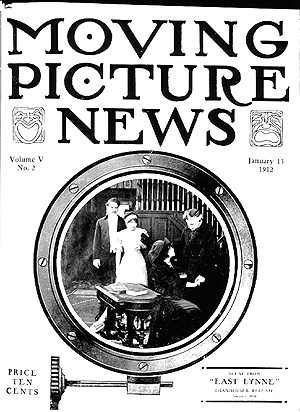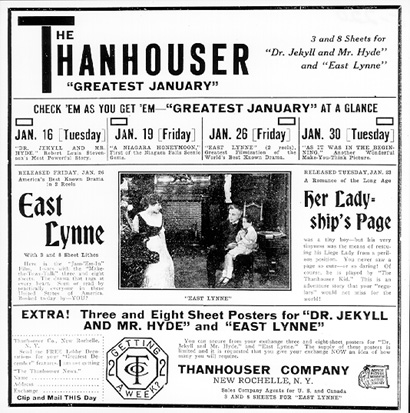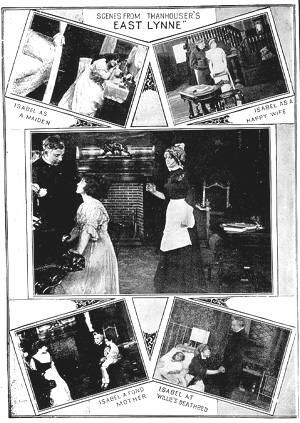 Volume II: Filmography
Volume II: Filmography Volume II: Filmography
Volume II: Filmography



From THE MOVING PICTURE NEWS, January 13, 1912. (F-210, F-220, F-200)
January 26, 1912 (Friday)
Length: 2 reels (1,881 feet)
Character: Drama
Scenario: Lloyd F. Lonergan, from Mrs. Henry Wood's novel of the same name
Director: George O. Nichols
Cast: James Cruze (Archibald Carlyle), Florence LaBadie (Lady Isabel), William Russell (Francis Levison), Marie Eline (Willie), Marguerite Snow, Harry Benham
Notes: 1. East Lynne was one of the most famous of all 19th century melodramas and was a standard feature on the English and American stage. 2. A scene from East Lynne appeared on the cover of the January 13, 1912 issue of The Moving Picture News, and several scenes were reproduced in the interior of the same issue. These same pictures were printed in The Moving Picture World, January 20, 1912. 3. The Motion Picture Story Magazine, issues of September and October 1913, credits Marguerite Snow with the role of Isabel and Florence LaBadie with the role of Barbara. The same publication misspelled the character Levison as "Lewiston" in several mentions.
ADVERTISEMENT, The Moving Picture World, January 20, 1912:
"Here is the 'Jam-'Em-In' Film. Issued with the 'Make-the-Town-Talk' three and eight sheets. The drama that tugs at every heart. Seen or read by practically everyone in these United States of America. Booked today by - YOU?"
SYNOPSIS, The Moving Picture News, January 13, 1912:
"PART ONE: Lady Isabel Vale, the daughter of an impoverished earl, marries Archibald Carlyle, a rising young lawyer. Carlyle's boyhood friend is Richard Hare, and prior to his marriage the gossips had suspected that Carlyle would marry Barbara Hare, Richard's sister. Barbara is secretly in love with Carlyle, but he does not suspect it, and his feelings toward her are purely brotherly. Almost immediately after her return from her wedding trip, Lady Isabel hears of this supposed romance and is disposed to be jealous of Barbara. Circumstances seem to confirm the gossip, for the husband and Barbara are surprised in a secret conference soon after his return from the wedding trip. So Lady Isabel's life as a bride opens with the belief that her husband is not true to her. Her husband does not explain, for she fails to tax him with his supposed treachery. The fact is, that Carlyle's friend, Richard, is a fugitive from justice. The father of the girl he loves is slain, and the evidence points strongly against Richard, although he is innocent. Barbara's conferences with Carlyle have been concerning her brother's case, as she is the only person he can trust to bring messages to Carlyle, his lawyer. Some years later, Sir Francis Levison, a fashionable rogue, is a guest at Carlyle's home and determines to win Lady Isabel. Finding that she is jealous of Barbara Hare, he goads her to fury by bringing the wife to the place where they meet. Lady Isabel, not knowing that her husband has just been in conference with Richard Hare, misconstrues his actions and to revenge herself agrees to elope with Levison, leaving a note telling her innocent husband that he has driven her to it. Carlyle receives the message and is comforted by his baby son, who is all that keeps the husband from utter despair.
"PART TWO: Lady Isabel, the wife of Archibald Carlyle, deserted him and eloped with Sir Francis Levison, who had traduced her husband. She soon bitterly regretted her foolish action but not knowing what to do and being friendless, drifted along for a year before she summoned up resolution enough to decide that she would separate from Levison. This action she took immediately after learning that Levison had deceived her, and that her husband was an honorable man. Accompanied by her infant child and the latter's nurse, Lady Isabel crossed to France. There the train on which she was traveling wrecked and many passengers were killed. The woman's child and nurse were among the victims, and through an error her name also appeared among those who had been killed. Although she did not die, Lady Isabel was severely injured and lingered in a hospital for months. While convalescing she read in an old newspaper that she had been reported killed, and she decided not to attempt to correct the error. At the hospital she was known as 'Madame Vine,' and under that name she decided to live a new life. While companion for a woman she is unexpectedly offered another position as nurse for her own son, a lad who she learns with horror is in delicate health. Her mother love determines her to risk the chance of detection, and, carefully disguised, she appears at her old home as a menial, but happy because she can again see her darling boy. She has many heartaches, however. She sees the woman she once regarded as her rival, now the happy and honored wife of her former husband, and hears her singing to him the songs that had once been sung by the Lady Isabel. Still she puts up with everything, working and praying for the recovery of her child, who is gradually sinking into a decline. Her petitions are not granted, and the boy dies. Before he passes away, however, the frantic woman reveals herself to him, and is surprised by her former husband. She appeals to him for forgiveness, he grants it, making her last moments peaceful and happy - the strain and grief had been too much for her and she sinks dead at the feet of the husband she had so cruelly injured. The man who had wrecked her home did not escape. Arrested for a murder he thought would never be traced to him, he was convicted and executed, while Barbara Hare's brother, wrongfully suspected and for years a fugitive with a price on his head, is cleared at last, and his sister rejoices that the last cloud has been lifted from her life, and that she can be happy with the love of her husband and the brother for whom she had sacrificed so much."
REVIEW, The Morning Telegraph, January 28, 1912:
"In the entire category of dramatic offerings in the English tongue there are few which have enjoyed the success of East Lynne. Likewise this production of the Thanhouser Company should prove true of the silent drama, for seldom have we enjoyed a photoization of a story or play as much as we did this. East Lynne, in the original text, is full of long speeches, overdrawn sentiment, mawkish appeal, which to many is almost repellent when compared with modern day playwriting. But at root it has a plot of virility, exceptional interest and a group of characters of remarkable contrast, but all of them exceedingly human. In this motion picture production, which tells the story remarkably well and, in fact, more entertainingly than the original, because of the lack of the ancient verbiage of the original, we are given a straightforward narrative staged with care and much outlay where required, and a series of portrayals worth remembering. Save, perhaps, that the costuming is modern, which might not appeal to those used to the quaintness of the old play in this point, it has so much and more of the familiar drama that it is deserving of naught but praise. And then again, why not modernize it in costume? There is no vital reason against it. We commend the production and advise its advertisement in advance of its showing by all exhibitors. It will not disappoint and will serve admirably the purpose of telling the story to those who may never have seen the stage version. It is in two reels and the tale is continued through both with easy presentation."
REVIEW, The Moving Picture World, January 20, 1912:
"A feature that has much to commend itself to Independent Exhibitors is a production of East Lynne in two reels by the Thanhouser Company. The subject is one that will never lose its popularity, and the filming of it by the Thanhouser artists brings out with commendable clearness all the great dramatic moments with which the story abounds. The Archibald Carlyle of the films is a true and fine counterpart of the Archibald Carlyle of the story. The photography and the settings deserve great praise. The vantage which the motion picture story enjoys over the conventional stage was again made manifest in this production by the marvelous realism of the railroad accident in which Lady Isabel lost her youth and her beauty. The wreck is visualized with more than common skill, the black-robed sisters ministering to the victims of the catastrophe making a most impressive picture."
REVIEW, The New York Dramatic Mirror, February 7, 1912:
"Excellent picture treatment of a high order has been afforded this old romantic drama, and the most discerning spectator must confess that sympathetic acting and clever construction of the film created an absorbing and dramatic delineation of events. The acting throughout is remarkably good and the two leading roles particularly well sustained. Particular credit is due the leading man. The picture has been placed into two reels. At the beginning of her married life Carlyle's wife becomes suspicious of Barbara, a friend of her husband, whose brother has been falsely accused of murder. The real culprit returns and incites the wife to leave Carlyle, showing her evidence of her husband's guilt and the former's secret meetings with Barbara, which, in reality, are in connection with freeing her brother from false accusations. The wife leaves her son and husband and marries this count, but his treatment of her compels her to seek divorce. She is reported lost among the dead of a railroad wreck, but after coming from the hospital, she seeks her old home and in the disguise of an old woman, becomes the nurse to her little boy. Her husband has married Barbara. Her son dies, and in her grief she exposes her identity, while the real culprit, her second husband, is forced into confession of his guilt, thus freeing Barbara's brother. It is put on with exceptionally good taste and care."
# # #
Copyright © 1995 Q. David Bowers. All Rights Reserved.